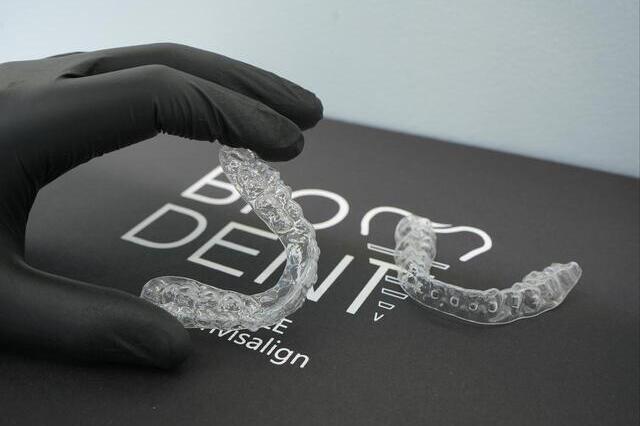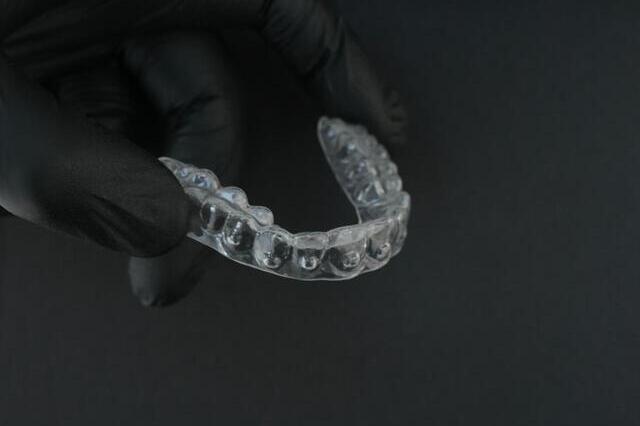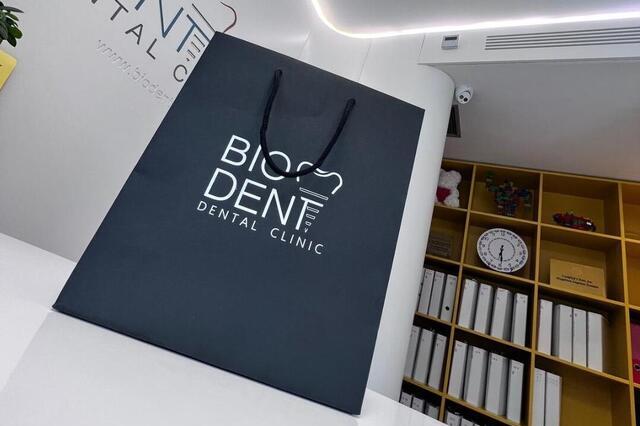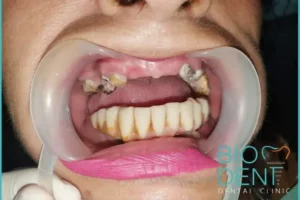Clear Braces

- At what age can you start using clear braces, and up to what age are they recommended?
- Who are clear braces not recommended for?
- How should you brush your teeth while wearing clear braces?
- What foods and drinks should I avoid to keep my clear braces from staining?
- Do clear braces hurt?
- How many hours a day should you wear clear braces?
- Will my teeth stay straight after treatment with clear braces?
- How often do you need to change your dental aligners?
Why do we recommend clear braces?
How many times have we heard that a smile is our best charm? Probably many, and it’s no coincidence: a healthy, perfectly aligned smile is a sign of beauty, hygiene and overall well-being.
However, having perfectly aligned teeth is not always easy, especially when it comes to correcting crooked ones.
Fortunately, modern dental technology helps us with clear braces, an aesthetic and innovative solution that is revolutionising the correction of crooked teeth. Made from transparent, biocompatible thermoplastic material with a light and discreet design, clear braces are worn over the teeth to gradually move them into the desired position, offering a natural and minimally invasive appearance.
In this article, we’ll explain how clear braces work and what makes them different from traditional orthodontic treatments. We’ll also explore when they can be used and what other options are available for correcting crooked teeth. If you want to learn everything about clear braces, keep reading!

What are the causes of crooked teeth?
Sometimes, people develop crooked teeth, a condition that can affect both children and adults and may have several causes. If you are facing this common concern, you are probably wondering what causes crooked teeth. Here are some of the most common reasons:
- Genetics: if your parents have crooked teeth, you are likely to inherit the same condition. There’s no reason for concern, crooked teeth are often the result of genetic factors and cannot be avoided.
- Extra or missing teeth: when there are too many teeth or some are missing, the remaining ones may shift out of place and cause misalignment.
- Gaps between teeth: having spaces between the teeth can also cause misalignment.
- Irregular jawbone growth: if the jawbones develop unevenly, the teeth may become misaligned.
- Oral habits: behaviours such as thumb-sucking or lip-biting can also contribute to the development of crooked teeth.
What dental problems can be corrected with braces?
Gapped teeth (Diastema)
The condition known as gapped teeth, or diastema occurs when an abnormal space develops between two or more teeth. It can affect both the upper and lower jaw.
Gapped teeth, or diastema can be caused by several factors, including extra or missing teeth, spacing issues, or irregular jawbone growth.
We’ve also become familiar with it thanks to a few celebrities. Who could forget Madonna’s stunning close-up in “Frozen”!
Dental crowding
Dental crowding is a common dental condition, particularly prevalent in developing countries.
It happens when the teeth lack sufficient space to grow properly and in alignment, causing them to overlap or tilt abnormally. This can lead to both aesthetic and functional issues, as it may hinder proper oral hygiene and increase the risk of cavities and malocclusion.
Dental crowding can be caused by genetic factors, poor dietary habits such as excessive sugar intake, or issues related to growth and development. To correct this condition, early treatment helps to maintain proper oral hygiene and good dental health, preventing the problem from getting worse.
Anterior crossbite
An anterior crossbite is a condition where the upper teeth sit inside the lower ones, preventing the chewing surfaces from meeting properly. This can cause problems with chewing and swallowing and may also affect the appearance of the smile. An anterior crossbite can result from jaw growth issues, malocclusion, or oral habits such as thumb-sucking or prolonged bottle use. If left untreated, it can lead to oral hygiene difficulties, tooth decay, and other dental problems.
Crossbite
A crossbite is an oral condition that can cause both aesthetic and functional problems. It occurs when one or more upper teeth sit outside the lower teeth, leading to an overlap of the chewing surfaces. This can make chewing and swallowing more difficult and may also affect confidence when smiling or speaking.
But that’s not all: a crossbite can also lead to oral hygiene problems, as it can make proper cleaning of the teeth more difficult, increasing the risk of cavities and other dental issues. If not treated, it can gradually become a more serious problem over time.
Open bite
An open bite is a dental condition that occurs when there’s an abnormal space between the upper and lower teeth when the mouth is closed. This can make chewing and swallowing difficult and may also affect the appearance of your smile.
An open bite can be caused by jaw development problems, malocclusion, or bad oral habits such as thumb-sucking. If left untreated, it may lead to difficulties in maintaining proper oral hygiene, as well as tooth decay and other dental problems.
Protruding jaw
The protruding jaw is a dental condition that occurs when the lower jaw is positioned forward in relation to the skull. This can cause difficulties with chewing and swallowing, and may also affect the appearance of the face.
A protruding jaw can be caused by jaw development issues, malocclusion, or bad oral habits. If left untreated, it can lead to oral hygiene problems, tooth decay, and other dental issues.
To correct a protruding jaw, treatment may include the use of orthodontic appliances or orthognathic surgery, which is performed to adjust the bone structure of the jaw.
How many types of dental braces are there?
There are several types of dental braces, each designed to treat specific dental conditions. Orthodontic treatments can be either fixed or removable and are used to correct bite problems such as dental crowding, crossbite, or underbite.
Fixed braces are attached to the teeth and remain in place for the entire duration of the treatment, while removable ones can be taken out for cleaning and better oral hygiene. Some types of braces are also designed to correct breathing issues, such as mouth breathing or snoring. There are also specific appliances used to treat jaw problems, including a protruding jaw.
No matter which type of braces you choose, it’s essential to follow your dentist’s instructions to achieve the best results and maintain good oral health.
Every now and then, someone asks this question:
How can I get straighter teeth without braces?
It’s simply not possible to straighten your teeth without using orthodontic treatment. Ignoring the problem can seriously harm your oral health. Crooked teeth can lead to bite issues, poor oral hygiene, and cavities, which in turn may cause infections and even permanent damage to your teeth. They can also cause pain and make chewing or swallowing difficult, ultimately affecting your overall quality of life.
Invisible braces for crooked teeth
An invisible brace for crooked teeth is a type of orthodontic treatment designed to correct misaligned teeth and bite problems.
It’s a discreet and almost invisible solution, perfect for anyone who wants to straighten their teeth without compromising their appearance. The invisible braces system is made up of a series of transparent plastic trays that fit over the upper and lower teeth.
These aligners are custom-made for each patient and can be easily removed for cleaning and oral care. Invisible braces are used to correct a variety of dental issues, including crowding, crossbite, and underbite. When used properly and under your dentist’s guidance, invisible braces can help you achieve a perfect smile in a discreet and comfortable way.

Who is the specialist that fits clear braces?
How does a clear braces consultation work?
If the patient is a suitable candidate for invisible braces to straighten crooked teeth, we will take a series of photos and dental impressions to create a digital model of the mouth.
Taking a digital dental impression is a quick and painless process. The dentist will first ask the patient to open their mouth and rest their tongue against the palate to get a clear view of all the teeth.
At this stage, the dentist uses an intraoral scanner, a small handheld device placed inside the patient’s mouth. It features a built-in camera and laser that capture detailed images of the teeth from every angle.
How are clear braces made?
The intraoral scanner sends the captured images to a computer, where they’re processed and transformed into a 3D digital model of the teeth. The dentist then uses this model to assess the patient’s dental condition and plan the most suitable treatment.
From this model, the clear braces are digitally designed for the patient to wear throughout the treatment.
The model is then sent to a 3D dental printer, a device that creates thermoplastic components using advanced layer-by-layer printing technology.
The 3D printer follows the digital model to produce a series of clear aligners made from biocompatible transparent thermoplastic material. They are then carefully polished and finished by the dentist or a specialised dental laboratory. Each aligner marks a new stage in the tooth-straightening process and is typically worn for around two weeks before being replaced with the next.
Clear braces are custom-made for every patient and are almost invisible, making them a popular choice for anyone who wants to straighten their teeth without the look or discomfort of traditional metal braces.
It’s essential that patients follow their dentist’s instructions carefully and wear their clear aligners as recommended. Over time, the teeth will gently move into the correct position, allowing the treatment to be completed successfully.
Clear braces: pros and cons
Clear braces are now one of the most popular solutions for people who want to improve their teeth alignment in a discreet, precise, and personalized way. This well-established technology allows treatments not only for aesthetic reasons but also to improve bite alignment, chewing function, and overall oral health.
Thanks to their effectiveness and minimal impact on daily life, clear braces make it possible to correct various dental imperfections while ensuring natural and long-lasting results. Like any orthodontic treatment, however, they offer several benefits as well as some aspects that should be carefully considered. Advances in digital planning and the use of safe, biocompatible materials have made clear braces one of the most trusted and appreciated options today, both by patients and dental professionals.
The benefits of clear braces
One of the main benefits of clear braces is their discreet appearance. Made from transparent, high-quality materials, they allow patients to smile, speak, and go about their daily lives confidently, continuing their routines with complete ease and comfort.
Beyond their aesthetic appeal, clear braces offer greater comfort than traditional fixed braces: the absence of wires or metal brackets prevents irritation to the gums, cheeks, and lips.
The ability to remove the aligners during meals and for daily oral hygiene is another major advantage. Patients no longer have to deal with the typical restrictions of fixed braces and can easily maintain thorough cleaning of their teeth and gums. It is much easier to brush, floss, and ensure effective hygiene, avoiding the buildup of food debris that often occurs with traditional braces.
Several studies have shown that patients using removable clear braces maintain a lower plaque index and healthier gums compared to those wearing fixed braces, where brackets and wires tend to trap debris and require more complex cleaning routines. This benefit, however, requires consistent commitment and adherence to the dentist’s instructions, as the dentist monitors progress and periodically replaces the aligners to ensure effective treatment and long-term oral health.
Finally, digital treatment planning represents one of the most innovative aspects of clear braces. Thanks to 3D scanners, virtual models, and computer simulations, it is possible to predict tooth movements with remarkable precision and preview the final result in advance. This allows for a fully personalized treatment plan for each patient, with clear timelines and defined stages, ensuring a predictable outcome and a transparent, reassuring process for the patient.
Things to consider before choosing clear braces
A Real Patient Story
Let me share the story of one of our patients. At the start of her treatment, she was very enthusiastic, but even though we had provided detailed written guidelines and carefully explained how the process works, she didn’t fully follow the instructions during the first few days. Worried that she wouldn’t be able to eat properly, she kept the aligner in during meals and didn’t remove it for proper oral hygiene. This caused discomfort, gum bleeding, and food residue between her teeth.
When she reached out to us, our team explained that the aligners should be removed only for eating and oral hygiene, and then put back in immediately afterward. It’s perfectly normal to feel some discomfort in the first few days, as the teeth start to move. We advised her to temporarily wear the previous set to relieve her gums and then continue with the new one.
Thanks to the explanations she received, the written guidelines provided from the very beginning, and the clinic’s ongoing support, she began following the instructions correctly: she wore the aligners for the recommended time, regained confidence in removing and reinserting them, and noticed a clear reduction in bleeding and discomfort.
By continuing her treatment as instructed, she is now achieving the results she hoped for, fully aware that working closely with the dental team and following the guidelines consistently are essential to achieving a harmonious, healthy, and long-lasting smile.

As a removable device, clear braces require discipline and consistent care. They should be taken out only for eating or brushing your teeth, and put back in immediately afterward. If they’re not worn for the recommended number of hours each day, treatment can slow down and the orthodontic plan may need adjustments.
In cases of more complex orthodontic conditions, such as significant tooth rotations or skeletal imbalances involving the upper or lower jaw, the dentist may recommend a combination of treatments or more suitable alternatives. During the first few days, it’s completely normal to feel mild discomfort or a sense of pressure; this simply means the aligners are applying the right amount of force to move the teeth. This temporary phase doesn’t interfere with normal daily activities.
Another key aspect to consider is daily cleaning. Aligners should always be kept clear and free of residue: if not cleaned properly, they can become stained or develop a yellowish tint. Clean them with cold water and a soft toothbrush, avoiding abrasive toothpaste or harsh cleaning products. Maintaining good oral hygiene — including thorough brushing, flossing, and regular dental check-ups — helps prevent plaque and tartar buildup, keeping your gums healthy throughout the entire treatment.
Results, Duration, and Maintenance
The results of a clear braces treatment depend on several factors, including the complexity of the case, the patient’s consistency, and how each person’s teeth respond to movement. In many cases, the first improvements can be seen after just a few weeks, as the aligners gradually begin to guide the teeth into their correct position.
On average, a complete clear braces treatment lasts between 6 and 18 months, depending on the severity of the malocclusion. During this time, patients change their aligners regularly, following their dentist’s instructions to ensure that tooth movements happen gradually and in a controlled way.
At the end of the active phase, the treatment continues with the retention stage, which is just as important for maintaining the results achieved. Patients need to wear a retainer, a clear aligner or custom-made device that keeps the teeth stable in their new position and prevents them from shifting back. Retention is a vital part of long-term success and helps ensure lasting stability of the smile.
As with any dental treatment, it’s also important to consider some practical aspects and potential limitations that may affect the final result.
The possible limitations of clear braces
It’s important to carefully consider the type of treatment and the level of expertise of the clinic you choose.
In Albania, dental care is generally more affordable than in many other European countries, thanks to the lower cost of living and clinic operations. However, if a quote is significantly lower than the local average, it’s worth asking why — a major price difference may indicate compromises in diagnosis, treatment planning, or materials.
A superficial diagnosis with limited follow-up checks increases the risk of uncontrolled tooth movements, longer treatment times, repeated refinements, or less stable results. Similarly, the use of uncertified or low-quality materials can reduce the transparency and durability of the aligners, making them more fragile, dull, or uncomfortable. In some cases, poorly finished or porous surfaces may even cause irritation to the soft tissues.
The laboratory phase plays a crucial role in achieving precise results. An inaccurate 3D print, uneven trimming, or poorly executed digital planning can affect the fit of the aligners and, consequently, the precision of tooth movements. Moreover, overly aggressive offers often result in fewer check-ups or limited support during treatment — whereas consistent clinical monitoring is essential to fine-tune details and consolidate progress over time.
At Biodent Dental Clinic in Tirana, Albania, we devote the utmost attention to quality at every stage of treatment. The initial assessment is thorough, digital planning is fully personalized, and thanks to our in-house dental laboratory, we produce the aligners directly on-site. This allows us to control every step of the process — from design to production — ensuring high-quality, long-lasting results and fair prices that reflect the level of care and service we provide.
This approach, combined with the continuous support of our team, allows our patients to achieve a harmonious smile with predictable, stable, and safe results.
To find out whether clear braces are suitable for your specific case and to learn more about the most appropriate treatment type and duration, we invite you to contact us. Our team will assess your situation, offer personalized advice, and guide you step by step toward a harmonious, stable, and long-lasting smile.
How much do clear braces cost at the Biodent Dental Clinic?
If you’re looking for a perfect smile without the look or discomfort of metal braces, clear braces are a modern, comfortable, and nearly invisible solution. They gently move your teeth into alignment, giving you a natural-looking smile and a comfortable experience from start to finish.
At Biodent Dental Clinic in Tirana, Albania, a full clear braces treatment costs €1,990. Each treatment plan is fully customised to suit your needs and the specific type of alignment required.
Keep in mind that a beautiful, well-aligned smile is a lifelong investment in your oral health, confidence, and overall happiness.
Schedule your free consultation with our specialists to discover whether clear braces are the best option for your smile and get your personalised treatment quote.
Our offers also include exclusive services such as:
- Round-trip transfers between the airport, hotel, and clinic
- Two nights of accommodation with breakfast included during your first visit
- Exclusive flight discounts for patients travelling to our dental clinic in Albania
Get in touch with us to find out more or to receive your personalised quote for clear braces treatment.

The most frequently asked questions to Biodent’s dentists in Albania about clear braces
At what age can you start using clear braces, and up to what age are they recommended?
Clear braces and other transparent orthodontic systems, such as Invisalign, can be used at any age, even in adulthood. However, it’s worth noting that treatment can sometimes be more complex and may take a little longer to complete than when started at a younger age.
At around 60 and beyond, the tissues in the mouth may become less elastic and more sensitive, which can make the treatment slightly more challenging. That’s why it’s important to talk to your dentist and carefully discuss whether starting orthodontic treatment with clear braces is the right choice at an older age.
In any case, it’s essential to follow your dentist’s instructions and wear your clear braces exactly as recommended to achieve the best possible results.
Who are clear braces not recommended for?
In general, clear braces are not recommended for people with advanced gum disease, poor oral hygiene, or other conditions that make it difficult to keep their teeth clean. They may also be unsuitable for patients with loose teeth or insufficient bone support.
How should you brush your teeth while wearing clear braces?
Brushing your teeth while wearing clear braces, such as Invisalign, takes a little extra care compared to when you’re not using any orthodontic device. Still, with a bit of practice and patience, maintaining good oral hygiene will quickly become second nature.
Here are a few useful tips on how to brush your teeth while wearing clear braces:
- Always remove your clear braces before brushing your teeth and place them in a container with cold water or a disinfectant solution.
- Use a soft-bristled toothbrush to avoid damaging the aligners or scratching your teeth.
- Use dental floss to remove plaque and food debris from areas that are difficult to reach with a toothbrush.
- Don’t forget to thoroughly rinse your clear braces under running water after each use to remove plaque and food particles.
- Follow your dentist’s instructions carefully, they can provide additional tips and guidance on how to brush your teeth effectively while wearing clear braces.
What foods and drinks should I avoid to keep my clear braces from staining?
To avoid staining your clear braces, try to limit foods and drinks that can leave marks, like red wine, sodas, fruit juices, and coffee. Also, make sure to rinse and clean your aligners carefully after every meal or drink to remove any residue and keep them crystal clear.
Do clear braces hurt?
Clear braces are usually much more comfortable than traditional metal braces. However, as with any orthodontic treatment, you may feel some mild pressure or soreness in your gums during the first few days. This temporary discomfort usually fades quickly as your mouth adjusts to the aligners.
This slight sensitivity simply means your clear braces are working as they should. If a tooth feels a bit loose when you touch it, it’s because the gums are creating space to let your teeth move into the correct position. Don’t worry, this space will naturally close, and your teeth will stabilise as the treatment progresses.
How many hours a day should you wear clear braces?
Clear braces should be worn for at least 20–22 hours a day to achieve the best possible results. Wearing them consistently throughout the day is essential, as this helps guide your teeth into the correct position.
However, it’s important to remove your clear braces when eating or drinking, as they can easily become damaged or stained. You should also take them out when brushing and flossing to ensure a thorough cleaning of your teeth and gums. In general, carefully following your dentist’s or orthodontist’s advice will help you achieve the best possible results with your clear braces.
Will my teeth stay straight after treatment with clear braces?
To keep your teeth straight after treatment, you’ll need to wear a retainer as advised by your dentist. A retainer helps keep your teeth in their correct position once your aligner treatment is complete, ensuring your new smile stays beautifully aligned over time.
A retainer is typically worn at night to prevent your teeth from shifting back to their original position. If you don’t wear it as recommended, your teeth may gradually move again, which could require further orthodontic treatment.
How often do you need to change your dental aligners?
Dental aligners are usually replaced every 2–4 weeks, depending on your specific case. A full treatment typically lasts between 6 and 18 months, depending on the complexity of your dental condition and how your teeth respond to the process.
It’s essential to follow your dentist’s or orthodontist’s guidance and switch your aligners exactly as outlined in your treatment plan.
- At what age can you start using clear braces, and up to what age are they recommended?
- Who are clear braces not recommended for?
- How should you brush your teeth while wearing clear braces?
- What foods and drinks should I avoid to keep my clear braces from staining?
- Do clear braces hurt?
- How many hours a day should you wear clear braces?
- Will my teeth stay straight after treatment with clear braces?
- How often do you need to change your dental aligners?
Our patients say!
Pubblicato suTrustindex verifica che la fonte originale della recensione sia Google. Dopo una pessima esperienza avuta lo scorso anno in Albania, ero molto diffidente nel rivolgermi di nuovo a una clinica dentistica. Tuttavia, BioDent ha completamente ribaltato le mie aspettative. Sin dal primo momento sono rimasto colpito dall’ottima accoglienza: personale gentile, professionale e capace di mettere subito a proprio agio. I lavori sono stati eseguiti con una minuziosità straordinaria, curando ogni dettaglio e spiegando passo dopo passo ciò che stavano facendo. Questa attenzione verso il paziente è qualcosa che raramente ho trovato altrove. La serietà e la trasparenza con cui operano mi hanno fatto sentire finalmente in buone mani. Dopo l’esperienza negativa dell’anno precedente, posso dire con certezza che BioDent rappresenta un punto di riferimento affidabile e altamente professionale. Consigliatissima a chi cerca qualità, cura e competenza.Pubblicato suTrustindex verifica che la fonte originale della recensione sia Google. I had a very nice experience at Bio Dent Clinic , i had very procedure done and i am very happy with the result .A big thank you to Biodent team for their support and help , especially doctor Lori during every step of my treatment.Truly recommended.Pubblicato suTrustindex verifica che la fonte originale della recensione sia Google. La migliore clinica di Tirana. Personali molto gentili, dottori bravissimi e molto competenti. La consiglio a tutti che devono fare qualche intervento dentale. Un grazie speciale alle ragazze della reception per la loro gentilezza.Pubblicato suTrustindex verifica che la fonte originale della recensione sia Google. Veramente molto cordiali,attenti all esigenze dei pazienti..e soprattutto umani!!!grazie biodentPubblicato suTrustindex verifica che la fonte originale della recensione sia Google. Ho trovato la clinica molto professionale impersonale gentilissimo e ospitalePubblicato suTrustindex verifica che la fonte originale della recensione sia Google. Personale qualificato, igiene al massimo, gentilezza e cortesia e professionalità, grazie a tutti e complimentiPubblicato suTrustindex verifica che la fonte originale della recensione sia Google. Clinica top ! Lavori eseguiti da professionisti seri , tutto lo staff veramente competente in tutte le specialità , ringrazio tutti per l’assistenza anche post lavori a distanza. Consiglio questa clinica a tutti non andate in altri posti , SCEGLIETE BIODENT fidateviPubblicato suTrustindex verifica che la fonte originale della recensione sia Google. Pune fantastike , faleminderit doktoreve dhe te gjithe stafit , kam ardhur posacerisht nga Zvicra ne kliniken Biodent dhe ndjehem shume i lumtur .
Start Your Treatment Journey
We’re here to help! Contact us for a personalized treatment plan or to learn more about our services.
Fill out the form today to secure your priority spot.
You might also be interested in related topics
We kindly ask for your patience: we’re gradually translating our website content to provide you with an even better experience. Thank you for your understanding.

Panoramica Dentale: perché è importante farla?
Una panoramica dentale, o radiografia panoramica, è una fotografia bidimensionale che cattura l’intera bocca di un paziente in un’unica immagine. Pensate alle impostazioni della fotocamera

Parodontite: cause, sintomi, effetti e cura
La parodontite, o malattia parodontale, è l’infezione dei tessuti che mantengono il dente in posizione e svolgono un ruolo importante nella biomeccanica del cavo orale.

Migliori Dentisti a Tirana: Scopri la Clinica Biodent in Albania
Il turismo dentale è ormai una realtà consolidata per chi desidera cure odontoiatriche di alta qualità a prezzi vantaggiosi. Sempre più persone scelgono l’Albania per
